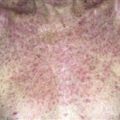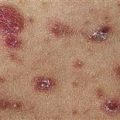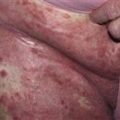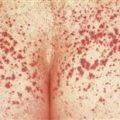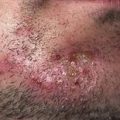143
Angiokeratoma
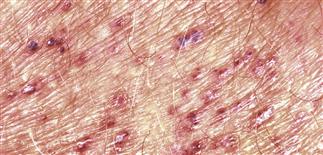
Angiokeratomas result from dilatation of superficial blood vessels and epidermal thickening.
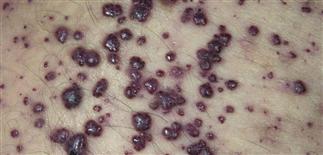
The classic lesion is a compressible, blue-black, discrete papule with a scant amount of scale.
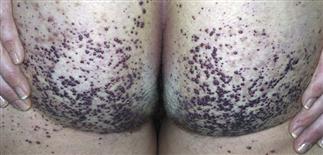
Angiokeratoma occurring on the buttocks in a patient with angiokeratoma corpus diffusion.
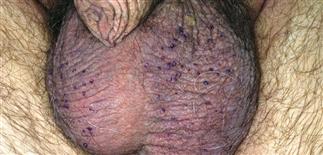
Angiokeratoma of Fordyce occurs on the scrotum and vulva. It appears in midlife and is permanent.
DESCRIPTION
Red to purple, scaly papules formed by dilatation of superficial blood vessels and epidermal thickening.
HISTORY
Common and most often seen as multiple lesions restricted to specific body sites. Undisturbed angiokeratomas persist indefinitely. Surface trauma often results in bleeding but not resolution. Four clinical variants • Angiokeratoma corporis diffusum (Fabry disease). In childhood and adolescence, boys develop episodic bouts of fever associated with severe pain in the extremities and abdomen, brought on by exercise and temperature changes; these crises can precede the angiokeratomas. Girls experience minor symptoms. Other affected organs: brain (transient ischemic attacks and stroke), heart (myocardial infarction), kidney (renal failure). Men usually die by age 50. Most males and many carrier females develop distinctive corneal opacities. X-linked recessive inborn error of metabolism caused by a deficiency of the lysosomal enzyme α-galactosidase A. Other lysosomal enzyme deficiencies (galactosidase-β1-fucosidase, β-mannosidase, neuraminidase) can produce similar symptoms. • Angiokeratoma of Fordyce. Most common. Asymptomatic multiple angiokeratomas symmetrically distributed on scrotum and vulva. Appears in mid life and persists indefinitely. Scrotal angiokeratomas may be associated with inguinal hernia, varicosities of leg, or varicocele; thus increased venous pressure thought to play a role. Vulvar angiokeratomas develop at a younger age in pregnant woman or with use of oral contraceptives. • Solitary or papular angiokeratomas. Occur equally in both sexes. Commonly occur as a single lesion on the legs of young adults; they may be multiple and occur in any location. Papular angiokeratomas are larger than the other variants and easily traumatized. • Angiokeratoma of Mibelli. Symmetric, grouped, multiple, occurring on the backs of fingers and toes. Appear during childhood and adolescence, continue to increase in number. More common in females. May be associated with chilblains or pernio. Inherited in an autosomal dominant manner.
PHYSICAL FINDINGS
A deep red to maroon, or blue to black, sharply defined papule of 0.5–1.0 cm. • Early lesions: light in color, soft, and easily compressed. • Older lesions: dark, warm, and raised, with surface scale.
TREATMENT
Cosmetically concerning and traumatized lesions can be treated with excision, electrosurgery, and laser surgery.

